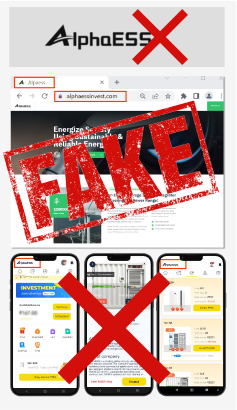-
Q:
Does my AlphaESS home battery need maintenance?
A:
AlphaESS home batteries are maintenance-free. The internet connection allows the system's software to receive regular updates.
-
Q:
Can Alpha energy storage system work without Internet?
A:
Alpha product needs an Internet connection (over wired Ethernet or your home Wi-Fi) to receive software updates and to communicate with the AlphaCloud for energy monitoring. A reliable connection is required to provide new product features over time. If its connection is temporarily lost, AlphaESS can continue to operate with its most recent settings, but it should not be installed in a location without Internet.
-
Q:
With which PV inverters are AlphaESS home batteries compatible?
A:
For all Alpha hybrid energy storage system, you can connect solar panels directly to it (= DC coupling).
All AlphaESS home batteries can be connected to an existing PV system. We call this an AC coupling. An AlphaESS system is completely independent of your existing solar panel system and can therefore be installed at any time.
-
Q:
For AlphaESS single-phase battery systems, can I still connect them to a 3-phase grid?
A:
es, you can. When connecting, 3-phase meters are used. These meters will ensure that the required power of the battery will be compensated on the 3 phases.
An example:
Two consumers each need 500 Watt at a certain moment and are connected to phase 1 and phase 2, for example. The battery system is connected to phase 3, and there is currently no demand for energy on that phase. The AlphaESS system then measures how much electricity is needed in total over the 3 phases at that moment (in this case 1000 Watt). This electricity is made available on phase 3 because the home battery is connected to that phase.
Because there is no consumption on phase 3 at that moment, the 1,000 Watt on phase 3 is injected into the electricity grid. At the same time, the 500 Watts needed by the users on phase 1 and on phase 2 are withdrawn from the grid. The same amount of electricity that the users need is therefore injected on phase 3 (1,000 Watts) and withdrawn on phase 1 (500 Watts) and phase 2 (500 Watts). In this case, the electricity meter is stopped, so there is no additional electricity cost.
-
Q:
Can I connect a single-phase battery system to a three-phase PV inverter?
A:
Yes, you can easily connect them in a house where there is a three-phase PV inverter.
-
Q:
What is the difference between kilowatt (kW) and kilowatt hour (kWh)?
A:
The power of the inverter is expressed in kW, the storage capacity of the battery in kWh.
-
Q:
Why is the useful storage capacity not 100%?
A:
A battery must always have some capacity left to be recharged. This is essential to be able to start the chemical reaction during charging. How deep you can discharge depends on the chemistry in the battery and to ensure a good battery life, it is best not to go to the limit. For example, a SMILE B3 battery module can be discharged up to 96% deep, which is very deep.
-
Q:
What are LiFePO4 / LFP batteries?
A:
LFP stands for Lithium Iron Phosphate. Charging or discharging a battery is essentially an electrochemical process. Lithium iron phosphate indicates the chemical composition of the cathode of a battery cell. AlphaESS only uses LFP cells which are known for their thermal stability, technical quality and outstanding safety. Moreover, these cells are completely free of cobalt.
The AlphaESS website uses cookies to improve and personalize your experience and to ensure that the website is functioning properly. Your data will not be stored on our website after the website is closed. By using this website, you agree to the use of cookies. More information about our Privacy Policy .Thank you very much!


Infringement of AlphaESS
Recently, a severe infringement and fraud issue has caught our attention. A FAKE application with a FAKE logo, a FAKE website https://www.alphaessinvest.com/ and even FAKE videos under the name of AlphaESS are now spreading all over India, attempting to seduce people to invest money in energy storage systems by using a FAKE AlphaESS logo and real AlphaESS products photos.
It's obvious that they are looting money by using a FAKE AlphaESS brand and have seriously violated the intellectual property rights of AlphaESS.
AlphaESS shall spare no efforts and no costs to go against the violation by all means legally before more people get deceived.
Mam ją


























